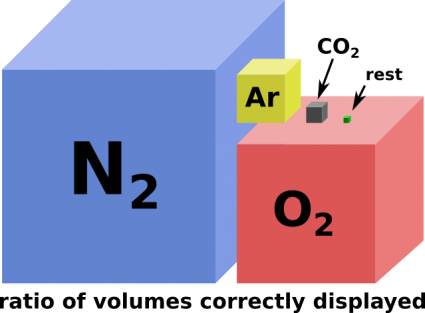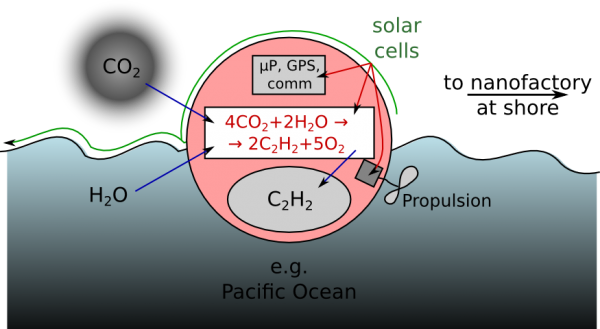Carbon dioxide collector
Template:Questionable article quality
[todo: split off makro and self replicating aspect from this page]
Contents
The problematic nature of all microscopic airbourn devices
Especially ships made from diamond may cause problems for all lung breathing life on earth. Silicosis a kind of lung damage often observed in mining workers may occur. Biominerals should be a lot less problematic and act more like natural dust. In great quantities they may create shadows hampering plant growth and even endanger planes.
Malicious air using ships
They may use the carbon that thay extract from the atmosphere solely for self replication act slowly to dont get detected by their waste heat and at some point start to produce nasty gasses like cyanide (HCN) or nitrous gasses (NOx) and may release them suddenly and in huge amounts.
If the extracted carbon is simply expulsed in form of graphite chips black graphite snow may have simmilar effects as oil spills.
Limiting effects: high altitude radiation, limit of available elements, low concentration of CO2 (usage of beta carbon nitride makes nitrogen available as building material)
Usage for the removal of CO2 from the atmosphere
Such devices do not need and should not be able to do self replication. Making such devices macroscopic and seaborne seems to be a better alternative. It makes handling them easier (even collectible by hand) allows for more control and less environmental spill. See: mobile carbon dioxide collector buoy. Locating solar cells for CO2 recuperation sparsely distributed in the air or on the sea instead of placing them concentrated in one place on the ground may be good for environmental (no paveover) and political reasons.
- Carbon extraction must stop at a certain level - otherwise all plants on earth are in severe danger.
- Every conscientously designed airbourn microship must care about its fate after their end of service.
Usage as sentinel
Watching out for malicious micro ships. If they have the same size as the agressor ships they may be most effective but then they may become a problem themselves.
- skysweepwers (term coined by J. Storrs Hall)
Water
Seaborne air using ships of easy handlable size like mobile carbon dioxide collector buyos have the potential to fulfill the global energy needs and remove the the excess CO2 that had accumulated due to burning of fossile fuels along with other unwanted gasses of industrial origin.
Swimming units have the benefit of easier access to wind power and easier propulsion. They can easily be kept stationary.
Air
Micro airships:
- have a very lightweight bubble as main body in a size range between 10um and 100.000um
- use depending on size thermal heating or hydrogen for lift
- use their surface for harvesting of solar energy
- are capable of water capture and splitting for compensation of hydrogen diffusion loss
- may be capable of carbon dioxide capture ond splitting
- may be capable of self replication
- may (if malicious) create some nasty gasses
Microscale
Violate spill avoidance guideline (that is keeping microcomponents and the like in macroscopic machine phase blocks) (see waste & recycling)
- Active dust?
- self replicating aerovores (name coined by J. Storrs Hall) - note: potentially misleading bioinspired name (wrongly suggests adaptability) ... skysweepers
- Danger for lung breathing life forms
Disassembly attack
Malicious parties could create an airborne micro ship that does try to find AP products and try to disassemble their microcomponents for whatever reason. That only works if they are mede of microcomponents that is they are non-monolothic. It would be bad if recyclability gets sacrificed only to defend against this.
As we know from tree pollen, particles as big as several tens of micrometers can be highly mobile in air and todays average houses let plenty of them leak in even if all windows and doors are closed. So one can't avoid such an attack by going indoors in conventionally built houses. Also usually one don't want to be forced to go through airlocks all the time and AP products shoulden't be confined to indoor use only.
One way to defend against such attacks may be to use hirachical locking that converges to some combination lock stones (locking mechanisms). The size of the protection code must be sufficciently big or else there must be very vew such stones since in the size of such an attacking particle fits a pretty powerful AP computer thus a massively parallel brute force coordinated random trial attack may be possible if the concentration of attacking microships is big enough. Even with a physical enforced delay between unlocking tests a too weak protection my be broken quickly.
To speed up their operation they may use air to self replicate (making them assemblers of the worst kind) or use the victim structures microcomponents for themselves if they fit or tap some energy that might be stored in the victim-structure.
[todo: can this be used for spam?]
Questions
To investigate: If replicative how fast could they replicate (doubling time) depending on their diameter?
What is the limiting factor: solar-power for hydrogen generation, diluteness of CO2 or something else?
To investigate: Can they be made to actively propel themselves? Their high volume to mass ratio makes this rather difficult when there's even the slightest bit of wind. Flattening the bubbles drops the aerodynamic resistance significantly.
To investigate: AP manufactured solar cells & mechanosynthetic carbon dioxide splitting
Alternate forms
For swimming ones - micro ships - essentially the same reasoning applies. They need only plain air as lifting medium must be sturdier can use the wind for propulsion and are easier to collect manually (skimming) if something goes wrong.
Extraterrestrial application
- usage in Gas giant atmospheres
- usage on Venus
Related
- Josh Hall's high altitude mirror bubble concept (not necessarily handling atmospheric gasses) [todo: add video link]

